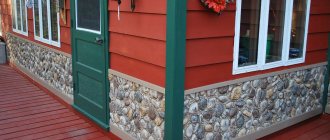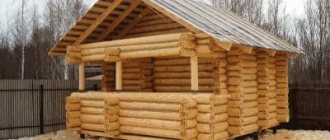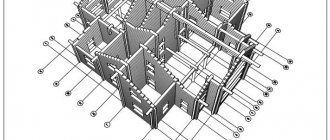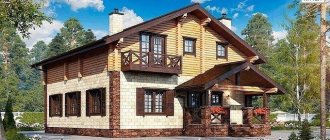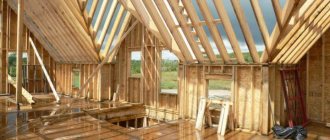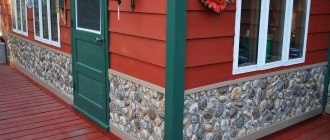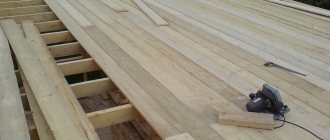Which foundation to choose for a wooden house?
- Types of foundations: shallow strip foundation
- Pile-grillage foundation
- Wooden house on a monolithic foundation
- Columnar foundation
- Screw pile foundation
The foundation is the support for the entire building, which is located underground. It takes on the main load of the structure exerted by the walls, roof, weather conditions, etc.
If the house is built of wood, then the question arises as choosing a foundation for a wooden house.
Scheme of a strip foundation.
There are 2 types of foundations: pile and natural. Foundations built on a natural basis are divided into columnar, slab, that is, monolithic and strip. The choice is largely characterized by the form and method of impact on the ground.
The foundation should be poured only after the developer has determined the place to build a wooden house, the house design has been fully approved, all the necessary engineering and geological studies have been carried out and the material for construction has been selected. Everyone knows that the reliability of the foundation is the key to the reliability and durability of a wooden house.
About 20% of the budget in building a house is spent on the foundation.
It should be taken into account that all defects when pouring the base will become apparent after a few years. For the developer, this will be an additional expense and will cause discomfort while living in the house.
Which brick is better for the foundation of a wooden house.
Scheme of a columnar foundation.
Choosing a foundation for a wooden house is a complex process that will require a lot of labor and patience. In the selected area, the engineering and geological properties of the soil should be carefully studied. This is an important issue that must be taken more than seriously. This includes studying the condition of the soil, the depth of its freezing, and the level of groundwater.
In addition, you should take into account the layout of the house, make calculations on its load on the foundation and the presence of basements. The most important point is the freezing of groundwater. When the soil freezes, it will swell, which will damage the foundation and tilt the entire house. Therefore, it is important to consider the depth of the foundation. Another important point during construction is waterproofing the foundation. High-quality waterproofing will permanently increase the service life of the base, protect against melt and ground water and from the penetration of capillary water into the concrete.
Pile foundation for a wooden house
Pile foundation for a wooden house
Wooden houses on pile foundations are built on unstable soils and uneven terrain. Another prerequisite is a high or constantly changing groundwater level. In addition, a pile foundation is a great way to reduce the cost of building a house and increase its maintainability.
Nuance. This type of foundation is not suitable for a basement. And, in addition, many practitioners argue that such a foundation is not suitable if it is planned to build a garage on a common foundation with the house. A large slope makes it difficult to enter the garage, especially in bad weather conditions.
The technology for pouring a pile type foundation is similar to a columnar one. The pile-screw foundation is different, in the construction of which metal screw piles are used. The difference is that in this case the supports are not dug into the ground, but are screwed into place. Because the pile has a drill at the end, which allows you to drill the soil to a depth below the freezing level. This simplifies work and reduces installation complexity and cost. Next, the pile is filled with concrete.
Nuance. There are known cases when frozen soil undermined the pile, so experts recommend making its side surface smooth. A film or asbestos pipe is suitable for this.
A grillage is also installed between the piles.
Types of foundations: shallow strip foundation.
You will need the following tools:
- bayonet shovels;
- shovels;
- hammer;
- sledgehammer;
- screwdrivers or screwdriver;
- level;
- bullet;
- cord.
For the formwork and the base itself you need:
- board or fiberboard 1.8-2 cm thick;
- beam;
- hot-rolled reinforcement with a diameter of 1-1.2 cm;
- knitting wire;
- concrete of a grade of at least M400.
Scheme of buried foundations.
Schemes of buried foundations.
Strip foundation is one of the most reliable types of foundation for the construction of wooden houses. This type of foundation consists of reinforced concrete. It is being built around the entire perimeter. This includes load-bearing walls and axial partitions. According to the characteristics of the soil and the depth of freezing of groundwater, a distinction is made between deep and shallow. A buried foundation, unlike a shallow foundation, is built below the freezing level of the soil. Among builders, the most popular is a shallow foundation, which has a rigid structure that can withstand very heavy loads. It can be built on heaving and very wet soils. To reduce the depth of soil freezing, builders insulate the top layer around the perimeter of the base.
A shallow strip foundation is often built for houses or bathhouses made of heavy wood. By making a choice in this direction, the developer will be confident in the strength and reliability of the foundation of a wooden house.
Strip foundation for a wooden house
Strip foundation for a wooden house
Strip foundation is one of the most common types of foundation. It has the same cross-section along the entire perimeter. Its width should be 50 mm. wider than the calculated width of the wall.
Subtypes of strip foundation:
Types of strip foundations for a wooden house
Deeply buried strip foundation. It is poured along the perimeter of the building and internal walls. Applies if:
- the soil on the site is classified as heaving;
- at a significant depth of soil freezing;
- when groundwater flows in close proximity to the soil surface;
- if there is a basement, ground floor, garage;
- in case of multi-storey construction.
Construction of a strip foundation for a wooden house
Construction technology:
- digging a pit. The depth of the foundation for a wooden house should exceed the soil freezing level by 200 mm. And the width is equal to the estimated width of the foundation, plus 400-500 mm. on formwork and ease of use;
- installation of a sand-cement cushion. To do this, a layer of mixture 150-200 mm thick is poured onto the bottom of the pit. To compact the mixture, you need to pour it with water and then compact it. Arranging a cushion will reduce the load on the foundation between seasons;
- installation of formwork. In order for the foundation surface to be level, you need to knock down the formwork from the inside and hammer the nails in from the outside. This technique will simplify the dismantling of the formwork.
Nuance. So that the dismantled formwork can still be useful, we advise you to choose the material for its construction based on further needs. For example, if you plan to use metal tiles as a roofing material, use cut boards for formwork. If bitumen shingles, then give preference to plywood. In this case, you need to fill the inside of the formwork with film. Thus, lumber can be used to construct a rafter system.
- To prevent the formwork from creeping under the pressure of concrete, spacers must be installed.
- installation of reinforcement. Metal rods can be laid in several rows. However, it should be remembered that welding work is not carried out when tying the reinforcement. The reinforcement bars are fastened to each other using wire;
- Pipes are installed between the fittings. They are needed for laying communications and ventilation.
- pouring concrete. Moreover, if the work lasts for several days, then each previous layer must dry. And the filling is carried out using the “wet” method.
Important. After each stage, you need to check the horizontal level with a building level.
Before starting construction of the building, the foundation must stand for several weeks. During this time, the foundation may sag and there will be time to fix the problems. Otherwise, shrinkage of the foundation will lead to shrinkage and deformation of the walls.
An alternative to a monolithic foundation is a block foundation. In this case, the blocks are laid out in several rows to the required height, fastened together with cement mortar and tied with reinforcing mesh.
Shallow strip foundation. MZLF is most often given preference in the construction of wooden houses. Since the weight of a wooden house is much less than a brick one.
The height of a shallow monolithic foundation ranges from 300 to 500 mm, therefore it is used in cases where it is necessary to reduce the cost of building a foundation without compromising its technical and operational characteristics.
A shallow foundation is used for temporary or light-weight small wooden buildings.
Pile-grillage foundation.
- concrete mixer;
- shovels;
- grinder for cutting reinforcement;
- Master OK;
- level;
- hammer.
This is an ideal option for lightweight wooden houses. It is often laid to great depth. This is done in cases where the soil is characterized by its weakness and is not able to withstand heavy loads. Such loads include high groundwater levels, quicksand and deep freezing of heaving soils.
Scheme of reinforcement of a pile-grillage foundation.
Scheme of reinforcement of a pile-grillage foundation.
When laying the foundation, piles are installed at all corners of a wooden house at a depth of 2 m. In addition, they are installed at the intersections of walls, under frame racks, load-bearing walls and in other places where there is a high load. The piles need to be installed at a distance of 1.5-2.5 m from each other. For the strip base, monolithic, reinforced piles are used. Builders also use asbestos pipes with concrete filling.
There is 1 more type of pile foundations. These are quickly erected pile foundations with a grillage. The pile foundation has permanent formwork. In addition to piles, there are grillages or beams at the base. The upper part of the pile is attached to the grillage with a gap above the ground of up to 10 cm. This will add rigidity to the structure. The construction of this type of foundation for a wooden building requires a small budget and is built very quickly.
Types of foundations for a wooden house
Wooden structures are characterized by low weight when compared with brick, concrete or stone buildings. Therefore, you can choose a lightweight type of base for a wooden house. In most cases, the following is used for wooden buildings:
Types of foundations for wooden houses
- Columnar foundation.
- Pile foundation.
- Monolithic concrete strip with reinforcement elements.
Columnar foundation
Such a basis for a wooden house is considered not only the best option, but also less expensive and labor-intensive. The following building materials can be used to build a base on pillars:
- Metal and asbestos-cement pipes, hollow inside.
- Reinforced concrete beams.
- Bricks.
- Foundation blocks measuring 20*20*40 cm.
The columnar foundation is erected in areas where there are slight differences in height and on heaving soils.
The construction of a foundation of this type involves installing pillars at a distance of 1.5-2 meters from each other, deepening them into the ground up to 1 meter, and also laying a sand cushion under each support.
Pile foundation
A foundation on piles is an ideal option for weak and marshy soils, as well as for areas with uneven terrain. Depending on the elements used as supports, a foundation of this type can be as follows:
Wooden house on stilts
- Pile-screw, where the piles are made of steel rods with screws in the form of a spiral at the end.
- Driven, in which reinforced concrete or metal piles are driven into the ground using special equipment.
- Drilled, which involves installing a casing pipe into a pre-drilled well and then filling it with concrete mass.
When building a house yourself, it is better to use screw piles, since only these elements can be immersed in the ground without the use of special equipment.
Concrete reinforced tape
The strip base is the most popular option. Such a base is made in the form of a reinforced strip, filled with concrete mortar and laid under external and internal load-bearing walls.
The tape can be buried, when the base is arranged below the soil freezing level, or shallow, if the depth of the foundation does not exceed 70 cm.
A strip foundation is a fairly strong foundation, but it is advisable to erect it for large, heavy buildings. The light weight of the structure may not withstand frost heaving, and the foundation will simply squeeze out their soil.
Wooden house on a monolithic foundation.
A monolithic foundation is built in the form of a rigid reinforced concrete slab. It is being built over the entire area of the house. Monolithic foundations are often built on subsiding clay soils or on weak soils with uneven compressibility. A monolithic foundation slab will ideally level horizontal or vertical soil movements. In order for the base to serve for a long time, it must be reinforced with reinforcement. This is a labor-intensive and complex process. Here you should take into account both the type of soil and the size of the house.
For correct calculations, it is best to invite an engineer with extensive experience in construction work. If the developer has chosen a monolithic foundation, then when building walls the supporting wall should be raised. This will prevent the lower logs from falling asleep with snow and will not lead to their rapid rotting. This type of foundation is one of the most expensive and costly. These include: high costs for installing a monolithic reinforced concrete slab. large volume of concrete and reinforcement.
Columnar foundation.
Scheme of a monolithic foundation.
Scheme of a monolithic foundation.
For country houses, which are used only in the summer season, a columnar foundation is used. This option refers to the non-recessed type. And to build it, you need to carefully study the characteristics of the soil. If the soil is very heaving, this type of foundation should be abandoned.
For a columnar foundation, brick, stone or reinforced concrete columns are used. For such pillars, holes should be dug with a volume of 0.12 m³. Crushed stone is poured into the bottom of the holes, which will serve as a reliable cushion for the posts. They are mounted at intervals of 2 m from each other along the perimeter of the entire house, under load-bearing walls, etc. The columns are connected using a tie-in. It connects the structure and is the lower crown of the house. It is treated with hydro- and heat-insulating compounds.
This very economical construction option has a number of disadvantages. Such a foundation does not provide for the presence of basements or a cellar, and is not designed to withstand heavy loads, and this will limit the developer’s use of the house in the future.
The advantage of a house built on a columnar foundation is the elevation of the house above the ground, which prevents the influence of melt water and groundwater on the walls of the house. Also, when the crowns are treated with a special compound, the house can last the same time as a stone one.
Columnar foundation for a wooden house
Columnar foundation for a wooden house
Material prepared for the website www.moydomik.net
The construction of a columnar foundation involves the use of concrete blocks, bricks, asbestos pipes, and pouring concrete into the formwork. It is used on heaving soils with a significant freezing depth. And also on uneven terrain and during the construction of houses that do not have a basement.
The use of such a foundation allows you to install the house on reliable ground and at the same time reduce concrete consumption. In this case, the pillars are installed at key points.
Construction of a columnar foundation for a wooden house
Construction technology:
- determine the location of the pillars. The distance between them depends on the length of the house, but should not be less than 1.5-2 m. It is mandatory to install pillars at the corners of the building, as well as at the junction and intersection of walls;
- deepen the pillar into the ground to a depth of 50-70 cm. A sand cushion under each pillar is a prerequisite for installing any type of support. If the pillar is manufactured at the installation site, it is necessary to make formwork and use reinforcement;
Advice. A more modern way to install poles would be to use TISE technology. It provides for the expansion of the support column at the bottom. This design is more durable and can be installed on any type of soil (excluding floaters). And easy installation allows you to speed up work and do without the use of equipment.
TISE foundation
- arrange a wooden or metal grillage on top of the pillars. Thanks to this, the load from the weight of the house will be evenly distributed between the supports.
Screw pile foundation.
When constructing such foundations, the following are used:
- piles at the tip (with standard thread);
- piles having a combined thread;
- piles equipped with blades.
This type of foundation is very effective when building wooden houses on a relief site or unstable soil. This is the main advantage of a screw foundation over other types. The foundation structure includes steel piles that support the weight of the house. Thanks to the screw blade at the bottom of the pile, which is screwed into the ground and reaches dense layers of soil, it rests on them. You can build a pile foundation with your own hands. There is no need to buy complex and expensive equipment to carry out the work. The master should call 3 assistants, with whose joint efforts the pile can be screwed into the ground.
Choosing a foundation for a wooden house is a responsible matter. You should also pay close attention to the filling process. The reliability and durability of the entire structure depends on how well the foundation is poured.
Screw
This type is applicable for all types of wooden buildings. It is noteworthy that maximum efficiency is achieved when building a house on unstable soil and uneven ground - here it shows all its advantages over any other types. The design of such a foundation is a set of load-bearing elements - steel piles - in the lower part of which there is a helical blade, thanks to which they are literally screwed into the thickness of the soil, reaching dense layers on which they subsequently rest.
The immersion of screws can be carried out using one’s own strength without the use of heavy equipment. True, the installation process requires the participation of at least three people, whose muscular efforts are used to screw in the load-bearing elements. Depending on the characteristics, each such load-bearing unit is capable of withstanding a load of 4 to 8 tons - an excellent indicator for the construction of relatively light (even two-story) houses.
The most important thing about the foundation for a wooden house.
Which blocks are better for the foundation of a wooden house.
Any wood, even if it is treated with special means, is destroyed much faster than all other building materials existing today. At the same time, those places where it comes into contact with the foundation are most unprotected. The fact is that it is here that the wood comes into direct contact with moisture, earth and air. The information presented below is step-by-step instructions on how to build a foundation for a wooden house with your own hands so that the house will serve “faithfully” for decades.
Features of the foundation for a wooden house
If you have certain skills and dexterity, it is quite possible to build a foundation for a wooden house with your own hands. Structures are erected from sufficiently heavy material - beams or logs.
When constructing one-story objects - baths, saunas - the load on the foundation for the extension will be less than when constructing complex multi-story architectural structures: residential buildings, private hotels and cafes.
Residential building
The choice of foundation type for construction and repair depends on many factors:
- the nature of the soil at the construction site;
- climatic conditions and temperature fluctuations in winter and summer;
- proximity to groundwater;
- stability of soil layers;
- material of load-bearing structures of walls and roof (timber, log or frame);
- degree of complexity of the object and number of floors;
- appointments;
- condition and degree of wear and tear of the building (when repairing the foundation of a house).
Buildings made from logs will naturally have the greatest weight compared to houses made from timber or frame.
When planning the construction of various kinds of decorative structures (balconies, verandas, bay windows), the load on the foundation for a one-story extension increases significantly and requires additional reinforcement of the support structures.
Timber structure
There are three main types of foundations for wooden buildings and extensions: monolithic, strip and grillage.
The optimal foundation option for wooden buildings.
“What is the best way to make a foundation for a wooden house?” To answer this question, it is necessary to consider in detail the criteria on which the choice of a design of one type or another depends. So:
- Location. Do not build in areas with unstable soil. You should also take care of connecting communications in advance.
- Number of floors. The more there are, the stronger the structure should be. In turn, an increase in area does not require these changes, since in this case the load on the structure remains exactly the same.
- Features of the project. Are they supposed to have, for example, a basement or ground floor?
- Soil type. Currently, the following types of soil are distinguished, which literally every person can determine without contacting a specialist: clayey - practically does not absorb water, in hot weather it becomes crusty;
- loamy - quickly absorbs water, dries out only after a couple of days;
- sandy – absorbs water with lightning speed and also dries quickly;
- peat - takes a very long time to dry; little vegetation;
- limestone – quickly absorbs water; in hot weather it becomes covered with a gray coating.
The above points are the main factors on the basis of which the optimal type of foundation for a wooden house is determined.
Construction of a strip foundation for a wooden house
The foundation in the form of a concrete strip is very popular among private developers. However, experts recommend building such a foundation in the following situations:
Strip foundation for a house
- If the soil on the site is characterized by a tendency to seasonal heaving.
- With close proximity to groundwater.
- With a high level of soil freezing.
- If the project involves the construction of a basement or ground floor.
- If the structure will have several floors.
Stages of construction of a strip foundation
The base in the form of a tape requires the following work:
- Digging a trench, which should be slightly wider than the foundation for more convenient arrangement.
- Laying a sand cushion that reduces the impact of seasonal soil movements on the foundation.
- Installation of the formwork structure with the necessary installation of supports and spacers.
- Reinforcement involving the laying of horizontal and vertical rods tied with wire.
- Laying pipes that are necessary for various communications and ventilation.
- Pouring concrete solution.
Types and types of foundations for wooden buildings.
Which foundation is better for a wooden house?
Types and types of foundation.
At the moment, the following types of foundations for a wooden house are distinguished:
The foundation for a wooden house is better.
The tape design is the most widespread today. It can be divided into the following groups:
- Recessed.
- Shallow.
- Not buried.
The construction of a buried strip foundation is relevant if the depth of soil freezing is significant, groundwater is very close to the surface, or the structure will have a basement, ground floor or garage.
Shallow construction is best suited for wooden houses. This is explained by the fact that the weight of such buildings is much less than brick ones. The height of a shallow foundation for a wooden house above the ground varies from thirty to fifty centimeters. For this reason, it is used in situations where it is necessary to save on the foundation without losing its quality.
A shallow foundation is suitable for small wooden buildings or those that are needed only temporarily.
The process of constructing a strip foundation can be represented in the following stages:
- Digging a pit. The depth of the foundation of a wooden house must necessarily be greater than the depth of soil freezing (about twenty centimeters). As for the width of the pit, this value is equal to the width of the foundation, to which half a meter is added for formwork and ease of work.
- Creating a cushion from sand and cement. A mixture of sand and cement is placed at the bottom of the pit. The thickness of the layer should be at least fifteen centimeters, and preferably twenty centimeters. The mixture must be compacted: to do this, it is first watered with plain water and then compacted. The purpose of the sand-cement cushion is to reduce the load on the structure.
- Creation of formwork. In order for the surface of the structure to be as smooth as possible, the formwork must be knocked down from the inside, and nails must be driven in from the outside. Following this advice will also make dismantling the formwork easier.
- Installation of spacers.
- Laying of reinforcement. Under no circumstances should elements be connected to each other by welding: only wire can be used.
- Pipe laying. They are necessary for communications.
- Pouring concrete.
Columnar foundation.
This design is suitable for soil with a serious freezing depth, which at the same time regularly swells. Also, this foundation can be used on uneven terrain.
The construction of a columnar structure involves the use of concrete blocks, bricks and asbestos pipes. Therefore, it is not suitable for buildings with a basement or ground floor.
The technology for constructing a columnar foundation is as follows:
- The location where the pillars will be installed is determined. Despite the fact that the distance between them is determined by the size of the house, it should not be less than one and a half meters.
- Installation of pillars. They go deep into the ground by approximately 50 - 70 cm. In this case, a sand-cement cushion must be made under each of them.
Pile foundation.
Such houses are built in areas with uneven terrain or when the soil is unstable. It is also suitable in situations where the groundwater level is high or changes frequently.
The pile structure is constructed in almost the same way as a column structure. The only difference is that the elements in this case are not simply driven into the ground, but are screwed into place. This is possible due to the fact that there is a drill at the end of each pile.
The foundation for a wooden house is better.
A slab foundation is indispensable for moving soil. The construction of this foundation involves the production of a monolithic concrete slab with reinforcement. Its area exactly matches the area of the house. One of the advantages of such a slab is that it is movable, so the house is not damaged when the ground moves.
The slab foundation is erected as follows:
- First, a pit is dug out. Since it will be large in size, it will most likely not be possible to do without the use of special equipment.
- Creating a pillow from cement and sand.
- Laying of reinforcement.
- Pouring concrete.
Installing a slab foundation is not an easy task. The main difficulty of this work is to achieve uniform drying of the concrete over the entire surface of the slab.
Therefore, if a tiled foundation is the only possible option, then it is best to seek help from a specialist.
Construction of a foundation for a wooden house
To answer this question, you need to consider the factors that determine the type of foundation:
- location of the house . It is the starting point for all subsequent geological surveys. It is important not to build a house near cliffs, ponds, or unstable soils. And also take into account in advance the possibility of connecting to communications (gas supply, electrification, water supply);
- dimensions and number of floors of the house . The greater the weight of the house, the stronger the foundation under it must be. But, at the same time, an increase in floors leads to a greater load on the foundation, but an increase in the total area of the house does not put forward such requirements, because the total load per unit area remains unchanged;
- designed basement, ground floor;
- terrain . With large unevenness, the construction of strip-type foundations will entail the need to remove a significant amount of soil;
- soil type and its bearing capacity . There are five types of soil. To determine the type of soil on a site, it is not necessary to contact special organizations; it is enough to observe the soil after rain;
- Clay soil slowly absorbs moisture and becomes crusty during drought.
- Loamy soil will absorb moisture quickly, but will dry completely only after a couple of days.
- Sandy will quickly absorb moisture, and you can start working almost immediately after the rain.
- Vegetation does not grow well on peat, and it takes a long time to dry out.
- Calcareous soil is able to quickly absorb moisture and is characterized by the appearance of a light gray tint to the soil during drought.
The type of soil determines its bearing capacity;
- depth of groundwater . The more moisture there is in the ground, in close proximity to the foundation, the greater the likelihood that the soil will swell when freezing/thawing;
- soil freezing depth . The base of the foundation must be below the freezing level of the soil;
- material consumption, timing and cost of work . Determined by the developer independently;
- aesthetics of the design . Also depends on personal preference. In any case, further covering the foundation of a wooden house with basement siding, plaster, etc. will achieve the desired effect.
Calculation and consideration of the above factors will allow you to select the desired type of foundation. Which foundation for a wooden house is better? You can choose the appropriate option after assessing all the factors described above.
Types and types of foundations for wooden houses
The low weight of wood suggests the use of the following types of foundation:
- tape;
- columnar;
- pile;
- slab.
Insulation of the foundation for a wooden house.
Now that we have looked at what types of foundations there are for a wooden house, let’s talk about the insulation of this structure. It is best to do this about a month after pouring the foundation before starting subsequent work. However, it is possible at another time, right up to the completion of construction. The main goals of insulation are to improve thermal and waterproofing properties.
Foam plastic, mineral wool and expanded clay are most often used as materials for foundation insulation. However, foam plastic is still the most popular. If the building has or has a basement or ground floor, then more material will be required, which should be taken care of in advance.
The main advantages of foam plastic over similar materials are:
- affordable price;
- decent level of strength;
- low thermal conductivity;
- resistance to moisture;
- ease of transportation and handling.
Size of foam boards.
Today, foam plastic boards are produced, the thickness of which ranges from 30 to 120 mm. The optimal size of foam boards for areas with a temperate climate is 50 mm. In the vast majority of cases, these slabs are laid in two layers.
The process of insulating the foundation using polystyrene foam can be divided into two stages: preparatory and main. Let's look at each of them.
Preparatory stage.
The first thing to do is to remove the soil around the perimeter of the house to the depth of soil freezing. After this, we clean the surface of soil residues and all other debris and then prime it. This can be done with a primer, which you can buy at any hardware store.
The next job is waterproofing the structure. Liquid rubber can be used as a waterproofing material, which is simply mixed and applied to the surface with a spatula, or rolled materials.
After completing all of the above steps, you can proceed to the main stage of insulation using polystyrene foam.
Main stage.
The foam boards are fixed very simply:
- Apply glue to the surface of the structure. This should be done in dots.
- We wait about a minute.
- Presses the slab well to the base.
There is no need to use any additional devices for fastening, since in addition to the glue, the foam board will also hold the soil.
We hope that the information provided has provided a comprehensive answer to the question: “What are the types and types of foundations for a wooden house?” and helped you decide on the best option in your case. Of course, you can do this work yourself. However, no one is immune from unforeseen situations. If you encounter any difficulties, seek help from a specialist.
Construction of a columnar foundation for a wooden house
The strength and reliability of any foundation depends on proper installation, which involves sequential execution of all actions.
Preparatory stage
Any construction is preceded by preparatory work, which most often involves cleaning the construction site and leveling it. First you need to remove large debris and excess vegetation. The area to be cleared should be larger than the planned foundation by approximately 3-5 meters in each direction. Next, the fertile layer of soil is removed, which is not suitable for the foundation; its thickness can reach 40 cm.
Preparatory stage
Further work depends on the composition of the soil under the top layer. If peat predominates at the construction site or the presence of silty soil is noted, then a complete replacement of such soil is required. If the fertile layer is followed by clay soil, then you can get by with a sand and gravel cushion. Sandy or gravelly soils can be used as a foundation base without additional soil reinforcement.
The cleared area must be well leveled. To do this, minor bumps can be leveled and soil can be poured into the recesses. The horizontality of the site is checked using a building level.
Site marking
At this stage, the foundation drawing is transferred to the construction site with precise adherence to the dimensions of the foundation and its location.
When marking a columnar foundation, the first to be placed is the cast-off, which consists of corner pillars connected by wooden slats. The cast-off should be located at the same distance from the perimeter of the foundation.
The dimensions of the future foundation are marked on the slats between the corner posts. According to the marks, axial lines are drawn indicating all the load-bearing walls of the house. The length of the axes is checked by measuring with a tape measure; they must be the same. In addition, it is necessary to check that the foundation angles are 90 degrees.
Next, move on to marking the location of the holes for the foundation pillars. In this case, it is important to take into account the distance between the supports; it is determined at the design stage. In addition, pillars should be placed under each intersection of load-bearing walls. During the marking process, it is necessary to ensure that the post holes are on the center lines.
Excavation
Each columnar support requires an individual pit. It should be 20-30 cm greater than the planned foundation depth. This is necessary for arranging a cushion under the pillar. The width of the pit should also exceed the size of the support, the best option is 20-40 cm. Such parameters make it possible to make formwork for pillars and install spacers without much difficulty. It should be taken into account that formwork may not be installed in holes up to 1 meter deep.
The holes can be dug by hand or special construction equipment can be used for the job.
A layer of sand about 10 cm thick is poured onto the bottom of the finished recesses, moistened with water and compacted well. Then gravel is poured in the same layer, which also requires good compaction. It is important that the sand and gravel cushion exceeds the dimensions of the support by about 10-20 cm.
Installation of formwork
Formwork for columnar foundation supports can be made from planed boards with a thickness of 20 to 50 cm, but in this case it should be taken into account that wood absorbs moisture very well. To solve this problem, you need to wet the material before use.
Formwork for columnar supports
You can use metal sheets, in which case the risk of formwork deformation under the action of the concrete mass will be minimal. However, the metal has significant weight and tends to adhere well to concrete, which can lead to the formation of defects in the pillars during the dismantling of the formwork structure.
In addition, asbestos, ceramic or iron pipes can be used as formwork. This element is installed in the prepared recess and filled with concrete mortar. In this case, the formwork is permanent.
Reinforcement of columnar supports
Pillar reinforcement
To create a reinforcing frame, rods with a diameter of 10-15 mm are used. To do this, take 3-4 rods and connect them, making a vertical bandage with soft wire every 15-20 cm. The finished frame is lowered into the prepared recess. In this case, it is important that the reinforcement rises 20-30 cm above the ground. This will greatly simplify the connection of the foundation with the future floor.
Pouring concrete
Now it’s time to concrete the recesses in which the formwork and reinforcing frame are installed. Concrete can be used ready-made and supplied with special equipment, but in most cases the solution is prepared with your own hands using a special technology.
It is recommended to pour the concrete mixture in portions so that one layer does not exceed 20-30 cm. After each concrete supply, compaction must be performed. For this purpose, you can use special deep vibrators. It is also possible to pierce the mixture with an ordinary metal rod. These actions help remove air bubbles from the concrete, thereby increasing the strength characteristics of the base.
The concreted surface is leveled and covered with any waterproofing material that will help protect the columnar base from the effects of precipitation.
We determine the best type of foundation for a log house.
Wooden houses are environmentally friendly and beautiful. In addition, subject to the technology of laying logs and appropriate processing of wood, they are also quite durable. The foundation is the basis for any structure, a wooden house is no exception. The wrong choice of base will lead to the formation of cracks, uneven shrinkage of the house, the appearance of gaps between the logs and even the complete destruction of the building. To decide which foundations for log houses you should best know the type of soil and the characteristics of the future structure.
When building a house from logs, the following types of foundations are mainly used:
Each of them has its pros and cons. To understand which foundation is better, you should evaluate their characteristics and installation methods.
What is the best foundation for a wooden house?
Slab foundation for a wooden house
Slab foundation for a wooden house
A slab foundation for a wooden house is used where difficult soils are present. The mobility of such soils is leveled by the production of a monolithic reinforced concrete slab, which is equal to the area of the house. A significant advantage of the slab is that it is movable, which means that the house is not deformed by the movement of the soil underneath it.
Pouring a slab foundation is a very costly and troublesome undertaking, consisting of the following stages:
- digging a pit. Due to its size, it will be necessary to attract additional equipment;
- arrangement of sand-cement cushion;
- laying of reinforcement;
- pouring concrete.
A particular difficulty in the construction of such a foundation is ensuring uniform drying of the concrete over the entire surface of the slab.
Monolithic foundation.
This type of foundation is a monolithic reinforced concrete slab and is the most expensive. Due to the fact that it follows the seasonal movement of the soil, it is called “floating”. Because of this, it is applicable to almost all structures, regardless of the type of soil and is able to withstand any load. However, before starting construction work, you should determine the groundwater level, the planned weight of the house and the type of soil.
- The construction of the foundation begins with clearing the site and digging a shallow pit (about 20-30 cm).
- Gravel and sand (10-20 cm high) are placed in the resulting depression, watered and thoroughly compacted.
- Waterproofing is laid on the prepared base to protect the slab from moisture.
- Then the formwork is installed.
- Next comes the installation of a frame made of steel rods. Basically, two layers of reinforcing mesh with a rod thickness of 12-16 mm are used. All this is held together with wire. The ends are insulated.
- After this, they begin pouring the concrete mass. The foundation for a log house is poured in one stage, otherwise its strength may suffer. The concrete is evenly distributed between the reinforcing bars. It will gain its strength within 1.5 months from the moment of pouring.
The grade of cement must be at least M300. The thickness of the slab depends on the building design. To build a house from logs, a slab up to 300 mm thick is required.
Sometimes inexperienced builders use a different type of foundation to build extensions. This is fundamentally wrong. It is strictly not recommended to combine a monolithic base with other types. Seasonal soil movement will cause the foundation for the log house to shift, and if there is a different type of foundation under the extension, then the ground movements will lead to a skew of its roof.
Features of foundations for log houses
Material costs for the foundation are estimated to be more than 30% of the construction budget. The question of reducing the cost of this amount is relevant. However, it is necessary to take into account the amount of loads that the foundation experiences. The weight of the building is determined from the design, but the final decision on the type of foundation is made only after soil studies, determination of the groundwater level (GWL) and topographic survey. Possible options: slab, strip, pile-grillage, columnar.
Slab
The monolithic reinforced concrete slab under the house is called floating: when the ground heaves, the elevations change. At the same time, the walls also shift, but the processes occur without distortions, which serves as protection against deformation breaks. Due to the high cost, slab foundations are rarely used in the construction of log houses. A strong argument for this choice is weak loose soils.
Tape
Strip foundations are well mastered by builders. They guarantee durability and predictability. It is believed that tape laid deeper than the freezing point is more reliable. But the lateral surface of the underground wall in this case is large, and ground shifts acting on it can cause destruction. The future is seen in shallow-depth tapes with a high base. This solves a number of problems:
- the cost of work is reduced;
- loads associated with tangential heaving forces are minimized;
- it becomes possible to pour the foundation at high groundwater levels.
Strip foundation. Choice and basic rules
Pile-grillage
It is relatively inexpensive, which justifies the construction of individual houses. Driving piles involves the use of special equipment and associated costs. This circumstance hinders the popularity of the method in private construction. Using modern technologies, you can install piles manually: screw piles are deepened by rotation, bored piles are poured directly on site. The function of the grillage during the construction of log houses is performed by the lower crown of the frame. Pile foundation is acceptable for loose rocks. The downside is the susceptibility to lateral shifts, which makes operation unpredictable.
Columnar
Installing pillars under a house is an economical option for solving the issue of foundation for a log house. The technology uses brick, concrete, timber. Laying under a residential building is advisable only on dense soils.
Columnar foundation.
This base option is the most economical. It cannot be used on heaving, unstable soils. Suitable for building houses on surfaces with plane differences of no more than 2 meters.
A columnar foundation for a log house is mainly used for light frame buildings or verandas. The pillars are made of brick, wood, asbestos pipes, concrete, stone or reinforced concrete. You can purchase ready-made concrete blocks. They are located in the corners of the building with an interval of 1.5-2.5 meters. And also under frame racks and at the intersections of walls.
Before constructing such a foundation, the depth of soil freezing should be determined.
The laying of pillars depends on this. Depending on the depth of freezing, it will be 10-30 cm. The depressions are filled with crushed stone and formwork is installed. Polyethylene or roofing felt is used as waterproofing. When properly installed, a columnar foundation for a log house is resistant to any frost.
Foundations for wooden houses
A log structure, depending on the type of soil and configuration, can be built on the following foundation:
- columnar;
- slab;
- tape
To build a house made of timber with a basement and thick walls, a strip structure is suitable. This design can also be made as a foundation for a lightweight dwelling made of wood, built on non-heaving soil.
It is not recommended to build a strip foundation if the soil is not dry enough or is susceptible to freezing. Due to the fact that such a base is durable, it is recognized as the best option for building a wooden house.
Preparing to pour the foundation of a log house.
By design, a distinction is made between monolithic and prefabricated foundations. The device of the latter includes blocks, the width of which is 0.3-0.6 m. The first row of the prefabricated structure is placed on a concrete platform, the height of which is 0.1 m, then the installation of subsequent ones begins. In this case, the vertical seams of adjacent rows should not coincide. The strength indicators, as well as the waterproofness of this design, depend on the total number of seams.
Before constructing a prefabricated base, you should worry about carrying out waterproofing work, increasing construction costs. This is the main reason for choosing a monolithic foundation. It is an inexpensive analogue and does not require special skills from the developer. You just need to study its structure and characteristic features.
Strip foundation.
A sandy, sandy-rocky or gravel type of soil is suitable for a strip foundation for a log house. To build such a foundation you do not need a large pit. The laying depth for central Russia on non-heaving soils should be 60-80 cm, and on heaving soils - about 1.5 meters. The width of the tape is slightly larger than the width of the wall and is about 30-40 cm.
A strip foundation is made along a closed contour.
- To do this, markings with ropes are made along the entire perimeter of the site according to the project.
- The top layer of soil is removed and a trench about half a meter deep is dug. When groundwater is close, it is increased.
- The trenches under each wall are lined with polyethylene film.
- Washed coarse sand is poured on top of the polyethylene, moistened with water and compacted.
- A wooden formwork is created and a reinforcing mesh of rods 10-12 mm in diameter is mounted into it, fastened with wire so that 30 cm cells are formed.
- A concrete mixture of crushed stone, sand and cement is prepared and poured in a ratio of 5. 3. 1. To evenly distribute the mixture between the reinforcement, it should be stirred with a shovel.
- Drying the base takes at least a month. To prevent drying out, the concrete is covered with damp burlap. And during rain, they are protected from getting wet by covering with polyethylene.
A strip foundation for a log house is very convenient in construction and much more economical than a monolithic one.
Pile-screw foundation.
Installing such a foundation takes little time and can be used for any type of soil, even loose soil. Piles are made of high quality steel with anti-corrosion coating. The structures look like a metal pipe with a pointed end. Their thickness depends on the load on the foundation. The material is selected for each specific building and piles are sometimes made to order.
Pile foundations for log houses are economical and easy to install.
- After calculating the number of piles, the location for installing the piles is determined. There is no need to clear the site. This foundation allows installation on any landscape.
- In the places designated for screwing in the piles, recesses are made. Then, using the principle of a screw, the structures are screwed in manually or using machines. Piles have a screw and blades with which they are screwed into the ground. Once the tip of the pile touches solid soil, the process is considered complete.
- Excess parts of the pile are removed and concrete is poured.
The foundation makes it possible:
- build a foundation on soft soil;
- build a house on a slope;
- build when groundwater lies close to the surface.
